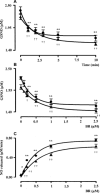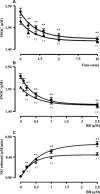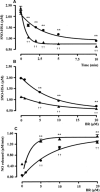Characterization of the S-denitrosylating activity of bilirubin
- PMID: 20141617
- PMCID: PMC9181359
- DOI: 10.1111/j.1582-4934.2009.00680.x
Characterization of the S-denitrosylating activity of bilirubin
Abstract
Bilirubin-IX-alpha (BR) is an endogenous molecule with a strong antioxidant feature due to its ability to scavenge free radicals. In this paper, we demonstrated that BR, at concentrations close to those found within the cell (0.1-2.5 microM), acted as a denitrosylating agent and increased the release of nitric oxide from S-nitrosoglutathione (GSNO) and S-nitrosocysteine (SNOC) (2.5 microM). The complexation of BR with saturating concentrations of human serum albumin (HSA, 2.5 microM) did not further increase nitric oxide release from GSNO and SNOC. At concentrations similar to those reached in plasma (5-20 microM), BR denitrosylated S-nitroso-HSA (2.5 microM), the main circulating S-nitrosothiol, and this effect was potentiated by the complexation of BR with saturating HSA (20 microM). Furthermore, the product(s) of the reaction between nitric oxide and BR were identified. Ultraviolet and mass spectrometry analysis revealed that nitric oxide binds to BR forming a N-nitroso derivative (BR-nitric oxide) with extinction coefficients of 1.393 mM(-1)cm(-1) and 2.254 mM(-1)cm(-1) in methanol and NaOH, respectively. The formation of BR-nitric oxide did not occur only in a reconstituted system, but was confirmed in rat fibroblasts exposed to pro-oxidant stimuli. These results provided novel insights on the antioxidant characteristic of BR through its interaction with nitric oxide, a gaseous neurotransmitter with a well-known dual effect, namely neuroprotective under physiological conditions or neurotoxic if produced in excess, and proposed BR-nitric oxide as a new biomarker of oxidative/nitrosative stress.
Figures






Similar articles
-
Bilirubin and S-nitrosothiols interaction: evidence for a possible role of bilirubin as a scavenger of nitric oxide.Biochem Pharmacol. 2003 Dec 15;66(12):2355-63. doi: 10.1016/j.bcp.2003.08.022. Biochem Pharmacol. 2003. PMID: 14637193
-
Albumin-bound bilirubin interacts with nitric oxide by a redox mechanism.Antioxid Redox Signal. 2006 Mar-Apr;8(3-4):487-94. doi: 10.1089/ars.2006.8.487. Antioxid Redox Signal. 2006. PMID: 16677092
-
Neuroprotective properties of nitric oxide.Ann N Y Acad Sci. 1999;890:301-11. doi: 10.1111/j.1749-6632.1999.tb08007.x. Ann N Y Acad Sci. 1999. PMID: 10668435 Review.
-
S-Transnitrosylation of albumin in human plasma and blood in vitro and in vivo in the rat.Biochim Biophys Acta. 2001 Apr 7;1546(2):422-34. doi: 10.1016/s0167-4838(01)00166-2. Biochim Biophys Acta. 2001. PMID: 11295447
-
The redox pathway of S-nitrosoglutathione, glutathione and nitric oxide in cell to neuron communications.Free Radic Res. 1999 Dec;31(6):641-50. doi: 10.1080/10715769900301211. Free Radic Res. 1999. PMID: 10630687 Review.
Cited by
-
Current Perspective of Hydrogen Sulfide as a Novel Gaseous Modulator of Oxidative Stress in Glaucoma.Antioxidants (Basel). 2021 Apr 26;10(5):671. doi: 10.3390/antiox10050671. Antioxidants (Basel). 2021. PMID: 33925849 Free PMC article. Review.
-
Prediction of severe neonatal hyperbilirubinemia using cord blood hydrogen peroxide: a prospective study.PLoS One. 2014 Jan 23;9(1):e86797. doi: 10.1371/journal.pone.0086797. eCollection 2014. PLoS One. 2014. PMID: 24466244 Free PMC article.
-
Panax ginseng and Panax quinquefolius: From pharmacology to toxicology.Food Chem Toxicol. 2017 Sep;107(Pt A):362-372. doi: 10.1016/j.fct.2017.07.019. Epub 2017 Jul 8. Food Chem Toxicol. 2017. PMID: 28698154 Free PMC article. Review.
-
Protein denitrosylation: enzymatic mechanisms and cellular functions.Nat Rev Mol Cell Biol. 2009 Oct;10(10):721-32. doi: 10.1038/nrm2764. Epub 2009 Sep 9. Nat Rev Mol Cell Biol. 2009. PMID: 19738628 Review.
-
Neuroprotective Effect of ω-3 Polyunsaturated Fatty Acids on Bilirubin Encephalopathy In Vitro and In Vivo.Med Sci Monit. 2018 Apr 28;24:2631-2638. doi: 10.12659/MSM.907131. Med Sci Monit. 2018. PMID: 29704452 Free PMC article.
References
-
- Kutty RK, Maines MD. Purification and characterization of biliverdin reductase from rat liver. J Biol Chem . 1981; 256: 3956–62. - PubMed
-
- Maines MD. Heme oxygenase: function, multiplicity, regulatory mechanisms, and clinical applications. FASEB J . 1988; 2: 2557–68. - PubMed
-
- Kapitulnik J. Bilirubin: an endogenous product of heme degradation with both cytotoxic and cytoprotective properties. Mol Pharmacol . 2004; 66: 773–9. - PubMed
-
- Ostrow JD, Pascolo L, Shapiro SM, et al . New concepts in bilirubin encephalopathy. Eur J Clin Invest . 2003; 33: 988–97. - PubMed
Publication types
MeSH terms
Substances
LinkOut - more resources
Full Text Sources
Other Literature Sources

